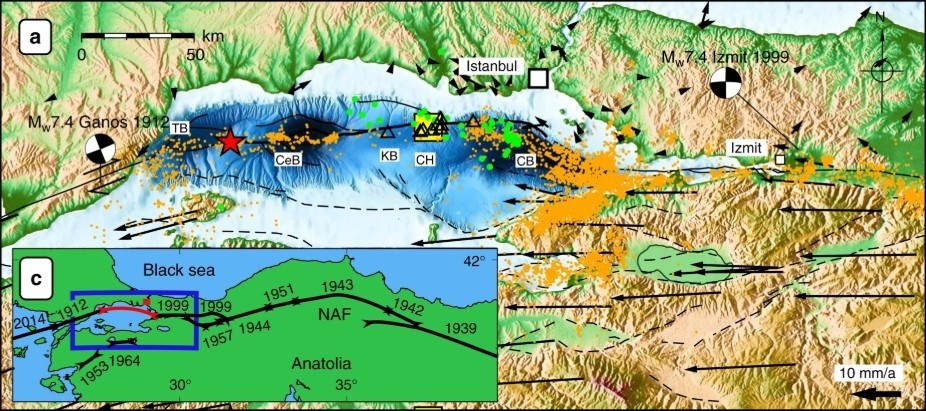
[ad_1]
A two-year underwater study conducted by German researchers revealed that the accumulation of tectonic strains on the infamous North Anatolian (NAF) fault could cause an earthquake of magnitude 7.1 to 7.4 just at south of Istanbul.
Turkey is one of the most earthquake-affected countries in the world, as it is located on several active fault lines. Dozens of earthquakes and secondary shocks occur each day. The most devastating fault line is the NAF, at the crossroads of the Anatolian and Eurasian plates. A slipped flaw that formed while the Anatolian plate was pushed north-west by the Arabian plate, the NAF produced devastating earthquakes throughout history.
The last time the section of the southern fault of Istanbul caused a major earthquake occurred on May 22, 1766, causing extensive damage to the city and causing thousands of deaths . In the west, the Ganos fault located some 20 kilometers south of the Tekirdağ province on the seabed caused an earthquake with a magnitude of 7.4 in 1912. In the east, the last major earthquake produced by the fault was of more recent memory. More than 17,000 people were killed and more than 43,000 injured when a magnitude 7.4 earthquake rocked the Marmara region for 37 seconds in the early hours of August 17, 1999, with its epicenter in the province of Gölcük, about 75 km southeast of the Bosphorus. Three months later, on November 12, 1999, 845 people were killed and nearly 5,000 wounded when a magnitude 7 earthquake hit the province of Düzce, about 120 km northeast of Gölcük.
 Image: Nature Communications
Image: Nature Communications
Following the route of the Anatolian plate, the main earthquakes on the NAF generally follow a line from east to west, although derogations such as the Düzce earthquake often occur. However, since 1999, Turkish and foreign seismologists have constantly warned the Istanbulites and the rest of the country against a "big problem" likely to hit the 15 million metropolises, urging citizens, local government and the government to take immediate precautions.
The seabed fault in the Marmara Sea – one of the least studied sections of the NAF since a topographic survey is not possible and GPS signals are not working properly – was a concern experts from the Helmholtz Kiel Ocean Research Center (GEOMAR), who were joined by their French and Turkish colleagues to conduct studies on the new GeoSEA system developed at the center. Ten measuring instruments were placed north and south of the fault at a depth of 800 meters and more than 650,000 distance measurements were made during the study, which showed that the tectonic strain had accumulated on the NAF.
"It would be enough to trigger another earthquake with a magnitude between 7.1 and 7.4," said geophysicist Dietrich Lange in a speech published on the GEOMAR website.
"Strong earthquakes occur when the fault zone is locked.Then the tectonic stress accumulates and the seismic energy is released during an earthquake," he said. he adds.
The GeoSEA system used by the researchers allows them to measure the deformation of the Earth's crust and the movement of tectonic plates with millimetric precision.
"In order to obtain precise measurements in a few millimeters over several hundred meters, a very precise knowledge of the speed of sound under water is necessary." Therefore, the pressure and temperature fluctuations of the Water must also be measured very precisely over the entire period, "explained Professor Heidrun Kopp, GeoSEA project leader and co-author of this study.
"Our measurements show that the fault zone in the Sea of Marmara is locked and that the tectonic tension is accumulating.This is the first direct evidence of the accumulated charge on the seabed in the south. Istanbul, "said Lange.
"If the accumulated stress is released during an earthquake, the fault zone would move more than four meters, which corresponds to an earthquake with a magnitude between 7.1 and 7.4", added Kopp.
The researchers, however, refrained from giving an exact or possible date to know when such an earthquake would occur.
The results of the study were published Monday in the journal Nature Communications.
[ad_2]
Source link